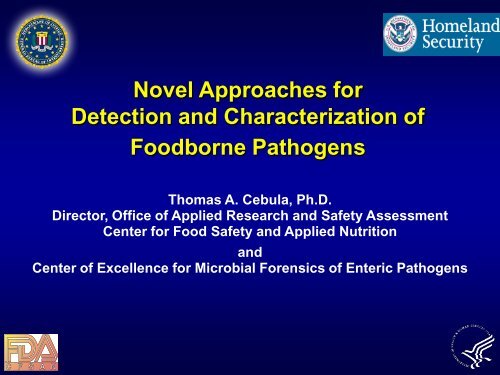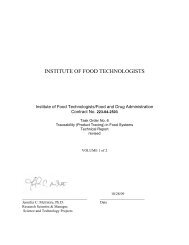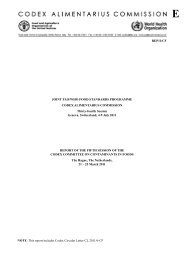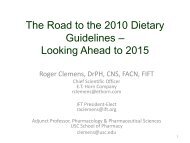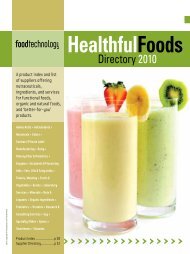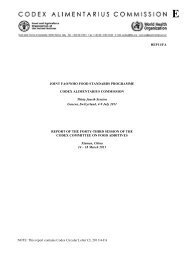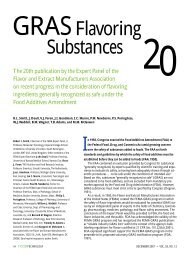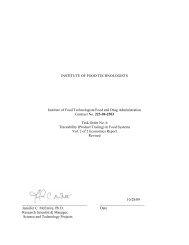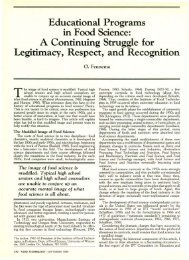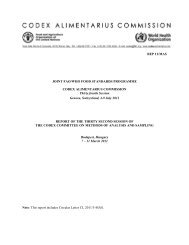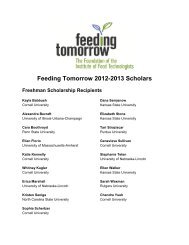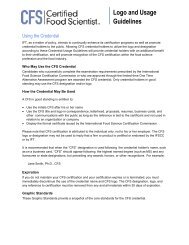Novel Approaches for Detection and Characterization of Foodborne ...
Novel Approaches for Detection and Characterization of Foodborne ...
Novel Approaches for Detection and Characterization of Foodborne ...
You also want an ePaper? Increase the reach of your titles
YUMPU automatically turns print PDFs into web optimized ePapers that Google loves.
<strong>Novel</strong> <strong>Approaches</strong> <strong>for</strong><br />
<strong>Detection</strong> <strong>and</strong> <strong>Characterization</strong> <strong>of</strong><br />
<strong>Foodborne</strong> Pathogens<br />
Thomas A. Cebula, Ph.D.<br />
Director, Office <strong>of</strong> Applied Research <strong>and</strong> Safety Assessment<br />
Center <strong>for</strong> Food Safety <strong>and</strong> Applied Nutrition<br />
<strong>and</strong><br />
Center <strong>of</strong> Excellence <strong>for</strong> Microbial Forensics <strong>of</strong> Enteric Pathogens
FDA/CFSAN/OARSA<br />
J. Eugene LeClerc<br />
Eric W. Brown<br />
Paula Davis<br />
Kim Dudley<br />
Alice Hay<strong>for</strong>d<br />
Scott Jackson<br />
Michael Kotewicz<br />
Baoguang Li<br />
Tammy Mays<br />
Kristen McCutchan<br />
Mark Mammel<br />
Amit Mukherjee<br />
W. Les Payne<br />
Andrei Perlloni<br />
Richard Raybourne<br />
Saura Sahu<br />
Andrew Shifflet<br />
The Perara Group, Inc.<br />
Junia Jean-Giles<br />
Isha Patel<br />
Dwayne Roberson<br />
Univ. <strong>of</strong> Maryl<strong>and</strong><br />
Suman Mukhopadhyay<br />
Univ. <strong>of</strong> Minnesota &<br />
Minnesota Dept. <strong>of</strong> Health<br />
Michael Osterholm<br />
John Besser<br />
James R. Johnson<br />
Univ. <strong>of</strong> Wisconsin<br />
Fred Blattner<br />
Nicole Perna<br />
DHS/NBFAC<br />
CAPT. James Burans<br />
FBI<br />
Mark Wilson<br />
Bruce Budowle<br />
Sidney Kimmel Cancer<br />
Mike McClell<strong>and</strong><br />
OpGen<br />
Colin Dykes<br />
NimbleGen<br />
Tom Albert
There are no such<br />
things as applied<br />
sciences,<br />
only applications <strong>of</strong><br />
science.<br />
--Louis Pasteur, 9/11/1872
The need <strong>for</strong>:<br />
•Identifying <strong>and</strong> recognizing patterns<br />
in a disease outbreak<br />
•Communicating those patterns to the<br />
public health community at large<br />
•Determing the pathogen involved<br />
•Containing the outbreak<br />
•Tracing the microbe to its source<br />
--Events <strong>of</strong> 9/11/2001 <strong>and</strong> after
Washington Post<br />
12/30/04
The <strong>for</strong>ensic continuum <strong>for</strong> strain identification<br />
“Strain could<br />
not have come<br />
from…”<br />
Exclusion<br />
“Strain did<br />
absolutely<br />
come from…”<br />
Attribution<br />
Differentiation<br />
<strong>of</strong> Strains<br />
Methods Validation<br />
Biomarker Stability<br />
Extent <strong>of</strong><br />
Genomic<br />
Diversity
Food Safety<br />
<strong>Detection</strong> at Genus Level<br />
<strong>Detection</strong> at Species Level<br />
<strong>Detection</strong> at Subspecies Level<br />
<strong>Detection</strong> at Serotype or Serovar Level
Food Defense<br />
<strong>Detection</strong> at Genus Level<br />
<strong>Detection</strong> at Species Level<br />
<strong>Detection</strong> at Subspecies Level<br />
<strong>Detection</strong> at Serotype or Serovar Level<br />
but, <strong>for</strong> attribution,<br />
<strong>Detection</strong> at Strain Level
Reference Strain Collection
Methods <strong>for</strong> Measuring Diversity<br />
Among E. coli O157:H7<br />
FDA Assembled a Diverse Collection <strong>of</strong> ~120 Natural Isolates<br />
<strong>of</strong> E. coli O157:H7<br />
1. Classical microbiological endpoints<br />
2. PCR-based strategies to assess ‘virulence’ genes, incidental markers, variable<br />
repeat regions, <strong>and</strong> the presence <strong>of</strong> IN-DELS occurring in bacterial genomes<br />
3. Comparative sequence analysis <strong>of</strong> multiple loci via conventional sequencing;<br />
Cladistic analyses to assess vertical <strong>and</strong> horizontal inheritance<br />
4. Pyrosequencing to provide real-time sequence data <strong>and</strong> useful in<strong>for</strong>mation <strong>for</strong><br />
confirming <strong>and</strong> identifying the presence <strong>of</strong> SNPs <strong>and</strong> their population frequency<br />
5. Whole genome arrays <strong>for</strong> genotyping <strong>and</strong> expression<br />
6. High density oligonucleotide microarrays that interrogate ~60 kb <strong>of</strong> the genome<br />
<strong>and</strong> precisely identifies polymorphisms occurring in the probed region<br />
7. Optical Mapping<br />
8. Phenotypic microarrays (Biolog) that allow rapid screening <strong>of</strong> up to 1200<br />
phenotypes, providing biological insight to our underst<strong>and</strong>ing <strong>of</strong> diversity
Comparative Genomic Analysis<br />
Of E. coli O157:H7 Using A<br />
<strong>Novel</strong> High-density, High-<br />
Throughput DNA Microarray<br />
Plat<strong>for</strong>m
Sampling ~1% <strong>of</strong> the E.coli O157:H7<br />
Genome at R<strong>and</strong>om<br />
5.5 Mb Genome<br />
- Sampled 1 kb per ~100 kb<br />
- Tiled 60 Loci onto Arrays<br />
Perna, N. T. et al. Nature 409, 529-533 (2001)
High Density Oligonucleotide Tiling Arrays Provide a<br />
“High Resolution” Snapshot <strong>of</strong> the Genome<br />
Reference Genome<br />
Test Genome<br />
29-mer Tiling Array<br />
Probes<br />
Mutation<br />
• Our Tiled Strategy Uses a 5 nt Probe Spacing<br />
• For a r<strong>and</strong>om sampling <strong>of</strong> ~1% <strong>of</strong> the genome, 1 kb <strong>of</strong> genome sequence was<br />
selected at 60 equally spaced regions around the EDL933 chromosome.
Interrogating 12 Independent Strains in Parallel<br />
1.5 cm<br />
~14,000 Spots (oligos)<br />
~4mm<br />
2 cm
Relative Probe Intensity vs. Genome Position<br />
Probes reporting a<br />
deletion in the test<br />
strain<br />
Probes reporting a<br />
SNP in the test<br />
strain<br />
Probes reporting identical<br />
sequence between strains
Validating Tiling Arrays: E.coli K-12 vs E.coli O157:H7<br />
EDL933/MG1655 Hybridizatio Ratio<br />
70.0<br />
65.0<br />
60.0<br />
55.0<br />
50.0<br />
45.0<br />
40.0<br />
35.0<br />
30.0<br />
25.0<br />
20.0<br />
15.0<br />
10.0<br />
5.0<br />
0.0<br />
-5.0<br />
1<br />
92727<br />
276613<br />
369339<br />
553226<br />
645951<br />
829838<br />
1013724<br />
1106450<br />
1290337<br />
1383062<br />
1566949<br />
1750835<br />
1843561<br />
2027448<br />
2120173<br />
2304060<br />
2487946<br />
2580672<br />
2764559<br />
2857284<br />
3041171<br />
3225057<br />
3317783<br />
3501670<br />
3594395<br />
3778282<br />
3962168<br />
4054894<br />
4238781<br />
4331506<br />
4515393<br />
4699279<br />
4792005<br />
4975892<br />
5068617<br />
5252504<br />
5436390<br />
EDL933 Position
Identification <strong>of</strong> Polymorphisms in E.coli K-12<br />
Deletion<br />
SNPs<br />
SNPs<br />
Insertion
• Over the 60 kb region <strong>of</strong> the K-12 genome<br />
interrogated, 814 independent polymorphisms occur in<br />
MG1655 relative to the tiled sequence <strong>of</strong> EDL933.<br />
• Of these, 806 differences were successfully called,<br />
indicating that the accuracy in detecting polymorphisms<br />
by this tiling array was greater than 99%.<br />
Of the eight polymorphisms that were not detected, four were SNPs reported in the Genbank sequence<br />
as either R (purine) or Y (pyrimidine). Two single nucleotide deletions that occur in MG1655 relative to<br />
EDL933 were not detected. Two undetected SNPs would have produced T/C mismatches upon<br />
hybridization, a polymorphism detected at many other sites in the MG1655 genome.
E. coli O157:H7 strain AB5
E. coli O157:H7 strain 508
E. coli O157:H7 strain 506
E. coli O157:H7 strain 488 is EDL933
0<br />
1<br />
2<br />
3<br />
4<br />
5<br />
6<br />
7<br />
8<br />
9<br />
10<br />
11<br />
12<br />
13<br />
14<br />
15<br />
92147<br />
92177<br />
184693<br />
184708<br />
276668<br />
368864<br />
369114<br />
369409<br />
553036<br />
553171<br />
645536<br />
645546<br />
738042<br />
829583<br />
921524<br />
921719<br />
921899<br />
922004<br />
922044<br />
922209<br />
922235<br />
1105925<br />
1105935<br />
1106125<br />
1106650<br />
1290107<br />
1290232<br />
1290582<br />
1474718<br />
1474943<br />
1567059<br />
1658535<br />
1658545<br />
1658575<br />
1658680<br />
1658695<br />
1658805<br />
1658810<br />
1658815<br />
1659015<br />
1659020<br />
1659025<br />
1659160<br />
1659165<br />
1659175<br />
1659215<br />
1659360<br />
1659415<br />
1659420<br />
1659425<br />
1751015<br />
2027993<br />
2027998<br />
2028003<br />
2119318<br />
2119493<br />
2119838<br />
2303920<br />
2303930<br />
2304370<br />
2395876<br />
2488451<br />
2580072<br />
2764289<br />
2764299<br />
2764459<br />
2764759<br />
2765124<br />
2948550<br />
2948775<br />
2949425<br />
3594095<br />
3778462<br />
3778472<br />
3869928<br />
4054614<br />
4146550<br />
4515048<br />
4607109<br />
4699614<br />
4791600<br />
4884216<br />
5067812<br />
SNP Position (EDL933)<br />
# Strains
Pyrosequencing – Sequencing by Light<br />
CGT<br />
CGT<br />
Polymerase<br />
CGT<br />
CGT<br />
Pooled<br />
Genomic<br />
DNA<br />
Allele-<br />
Specific<br />
PCR<br />
CGT<br />
Sulfurylase<br />
CGT<br />
CAT<br />
CGT<br />
90% C<br />
Luciferase<br />
CGT<br />
CGT<br />
10% T<br />
C<br />
T
Pyrosequencing assay <strong>for</strong> SNP identification<br />
GCG<br />
GTG<br />
GCG<br />
Sequence<br />
CAGCGGT<br />
GCG<br />
GCG<br />
GCG<br />
CAGTGGT<br />
GTG<br />
GCG<br />
GTG<br />
GCG<br />
70% CAGCGGT<br />
30% CAGTGGT
strain serotype 4889b 4889a 5210 i559 roi NG1 NG2 NG7 4777 5096<br />
EC1214 O157:H7 A G C G G del T G G G<br />
EC506 O157:H7 A G C G A A T C G G<br />
EC868 O157:H7 A G C G A A T C G G<br />
86-24 O157:H7 A G C G A A T C G G<br />
EC509 O157:H7 A G C G A A T C A G<br />
EC536 O157:H7 A G C G A del T G G G<br />
EC484 O157:H7 A G C G GA A T C G G<br />
EC869 O157:H7 A G C A A del G G G G<br />
AB3 O157:H- A G C A A del G G G G<br />
EC510 O157:H- A G C A A del - - G G<br />
EC554 O157:H7 A G T G G A T C G C<br />
EC559 O157:H7 A G T G G A T C G C<br />
EC866 O157:H7 A G T G G A T C G C<br />
EC1219 O157:H7 A G T G G A T C G C<br />
95-01A O157:H7 A G T G G A T C G C<br />
AB1 O157:H- A G T G AG A T C G C<br />
EC558 O157:H7 A G T G GA A T C G C<br />
EC505 O157:H7 A A C G A A T C A G<br />
EC512 O157:H7 A A C G A - T C A G<br />
DEC7A O157:H43 G G C G G del T C G G<br />
EC521 O26:H11 G G C A G del G G G G<br />
EC1216 N.D. G G C A A del - - G G<br />
EC884 N.D. G G C A AG del - - G G<br />
DEC5C O55:H7 G G C - AG del G - G G<br />
barcode<br />
0000010100<br />
0000100000<br />
0000100000<br />
0000100000<br />
0000100010<br />
0000110100<br />
0000200000<br />
0001111100<br />
0001111100<br />
0001112200<br />
0010000001<br />
0010000001<br />
0010000001<br />
0010000001<br />
0010000001<br />
0010200001<br />
0010200001<br />
0100100010<br />
0100120010<br />
1000010000<br />
1001011100<br />
1001112200<br />
1001212200<br />
1002211200
•Bacterial genomes are known to be mosaic<br />
structures due to extensive recombination <strong>and</strong><br />
horizontal gene transfer occurring throughout their<br />
evolution.<br />
•The overall organization <strong>of</strong> a genome might vary<br />
between two strains observed to be similar in gene<br />
content.<br />
•Genome organization might there<strong>for</strong>e help to<br />
identify <strong>and</strong> discriminate between related strains.
4<br />
0<br />
3<br />
2<br />
0<br />
4<br />
5<br />
2<br />
3<br />
3<br />
1<br />
0<br />
6<br />
1<br />
2<br />
3<br />
0<br />
0<br />
0<br />
1<br />
0<br />
2<br />
1<br />
1<br />
2<br />
2<br />
1<br />
2<br />
0<br />
1<br />
3<br />
2<br />
1<br />
0<br />
4<br />
4<br />
4<br />
8<br />
4<br />
0<br />
1<br />
2<br />
3<br />
4<br />
5<br />
6<br />
7<br />
8<br />
9<br />
86-24<br />
93-111<br />
AB1<br />
AB2<br />
AB4<br />
AB5<br />
AB6<br />
AB8<br />
EC1214<br />
EC1219<br />
EC1220<br />
EC1221<br />
EC1223<br />
EC1227<br />
EC1228<br />
EC1231<br />
EC486<br />
EC488<br />
EC502<br />
EC504<br />
EC505<br />
EC506<br />
EC507<br />
EC508<br />
EC536<br />
EC866<br />
EC868<br />
EC869<br />
EC870<br />
EC871<br />
EC873<br />
EC874<br />
EC875<br />
EC877<br />
EC878<br />
EC881<br />
EC882<br />
EC886<br />
EC887<br />
Strain<br />
# CNPs
Optical Mapping: A Single Molecule Technique<br />
<strong>for</strong> Generating Whole Genome Restriction Maps<br />
Genome Map
Method <strong>for</strong> Generating Optical Maps from E. coli<br />
1. Chromosomal DNA Preparation:<br />
• Intact chromosomal DNA is recovered from E. coli embedded in agarose<br />
plugs.<br />
2. DNA Mounting, Overlay, Digestion, <strong>and</strong> Staining:<br />
• Whole DNA molecules are recovered from agarose plugs <strong>and</strong> mounted on<br />
derivatized glass surfaces<br />
• Immobilized DNA is digested<br />
• DNA is fluorescently stained<br />
3. Image Acquisition <strong>and</strong> Processing:<br />
• Samples are imaged by fluorescence microscopy <strong>and</strong> a high-resolution digital<br />
camera.<br />
4. Map Assembly:<br />
• Individual-molecule restriction maps were overlapped by aligning restriction<br />
sites based on fragment sizes by using specially written s<strong>of</strong>tware.
Optical Mapping: Image Analysis<br />
Single DNA molecule on Optical Chip after digestion, staining<br />
Image analysis s<strong>of</strong>tware measures size <strong>and</strong> order <strong>of</strong> restriction<br />
fragments Converts “optical” data into digital data - barcodes<br />
Overlapping single molecule maps are aligned to<br />
produce a map assembly covering an entire<br />
chromosome
Multiple Coverage is Necessary <strong>for</strong> Accurate<br />
Map Assembly
Alignment <strong>of</strong> Optical Maps to a Reference<br />
Genome Map
Insertions, Deletions, <strong>and</strong> Rearrangements Can be<br />
Identified from Optical Mapping
Optical Map <strong>of</strong> EC536 Shows a Deletion <strong>of</strong> ~65<br />
kb Occurs in EC536 Relative to EDL933<br />
EDL933<br />
1331570bp - 1394263bp<br />
152 158<br />
~63 kb<br />
Deletion<br />
EC536<br />
EDL933 Position 1377163 – 1388578 is O-isl<strong>and</strong> #45<br />
Region <strong>of</strong> the EDL933 chromosome not homologous to E. coli K-12 MG1655
Optical Maps are Well Suited <strong>for</strong> Strain<br />
Identification <strong>and</strong> Strain Relatedness Studies
Cladistic Analysis <strong>of</strong><br />
Escherichia coli O157:H7
S. enterica<br />
mdh Parsimony<br />
I<br />
II<br />
ECOR10<br />
ECOR6<br />
ECOR14<br />
ECOR27<br />
ECOR32<br />
ECOR69<br />
ECOR70<br />
ECOR58<br />
ECOR64<br />
ECOR52<br />
ECOR62<br />
ECOR61<br />
ECOR59<br />
ECOR66<br />
ECOR35<br />
ECOR40<br />
ECOR47<br />
ECOR44<br />
ECOR46<br />
ECOR50<br />
ECOR49<br />
ECOR38<br />
ECOR37<br />
ECOR30<br />
ECOR45<br />
ECOR10<br />
ECOR6<br />
ECOR14<br />
ECOR27<br />
ECOR32<br />
ECOR69<br />
ECOR70<br />
ECOR58<br />
ECOR64<br />
ECOR52<br />
ECOR62<br />
ECOR61<br />
ECOR59<br />
ECOR66<br />
ECOR35<br />
ECOR40<br />
ECOR47<br />
ECOR44<br />
ECOR46<br />
ECOR50<br />
ECOR49<br />
ECOR38<br />
ECOR37<br />
ECOR30<br />
ECOR45<br />
mdh Neighbor-Joining
S. enterica<br />
I<br />
II<br />
mdh Parsimony<br />
ECOR10<br />
ECOR6<br />
ECOR14<br />
ECOR27<br />
ECOR32<br />
ECOR69<br />
ECOR70<br />
ECOR58<br />
ECOR64<br />
ECOR52<br />
ECOR62<br />
ECOR61<br />
ECOR59<br />
ECOR66<br />
ECOR35<br />
ECOR40<br />
ECOR47<br />
ECOR44<br />
ECOR46<br />
ECOR50<br />
ECOR49<br />
ECOR38<br />
ECOR37<br />
ECOR30<br />
ECOR45<br />
ECOR10<br />
ECOR6<br />
ECOR14<br />
ECOR27<br />
ECOR32<br />
ECOR69<br />
ECOR70<br />
ECOR58<br />
ECOR64<br />
ECOR52<br />
ECOR62<br />
ECOR61<br />
ECOR59<br />
ECOR66<br />
ECOR35<br />
ECOR40<br />
ECOR47<br />
ECOR44<br />
ECOR46<br />
ECOR50<br />
ECOR49<br />
ECOR38<br />
ECOR37<br />
ECOR30<br />
ECOR45<br />
mdh Neighbor-Joining
ECOR27<br />
ECOR70<br />
ECOR10<br />
ECOR61<br />
ECOR45<br />
ECOR14<br />
ECOR50<br />
ECOR49<br />
ECOR46<br />
ECOR44<br />
ECOR47<br />
ECOR35<br />
ECOR64<br />
ECOR62<br />
ECOR66<br />
ECOR52<br />
ECOR59<br />
ECOR40<br />
ECOR38<br />
ECOR32<br />
ECOR58<br />
ECOR69<br />
ECOR37<br />
S. enterica<br />
ECOR10<br />
ECOR6<br />
ECOR14<br />
ECOR27<br />
ECOR32<br />
ECOR69<br />
I<br />
II<br />
I<br />
II<br />
ECOR70<br />
ECOR58<br />
ECOR64<br />
ECOR52<br />
ECOR62<br />
ECOR61<br />
ECOR59<br />
ECOR66<br />
ECOR35<br />
ECOR40<br />
ECOR47<br />
ECOR44<br />
ECOR46<br />
ECOR50<br />
ECOR49<br />
ECOR38<br />
ECOR37<br />
mdh<br />
mutS<br />
ECOR30<br />
ECOR6<br />
ECOR30<br />
ECOR45
ECOR27<br />
ECOR70<br />
ECOR10<br />
ECOR61<br />
ECOR30<br />
ECOR45<br />
ECOR6<br />
ECOR14<br />
ECOR50<br />
ECOR49<br />
ECOR46<br />
ECOR44<br />
ECOR47<br />
ECOR35<br />
ECOR64<br />
ECOR62<br />
ECOR66<br />
ECOR52<br />
ECOR59<br />
ECOR40<br />
ECOR38<br />
ECOR32<br />
ECOR58<br />
ECOR69<br />
ECOR37<br />
S. enterica<br />
ECOR10<br />
ECOR6<br />
ECOR14<br />
ECOR27<br />
ECOR30<br />
ECOR45<br />
ECOR32<br />
ECOR69<br />
I<br />
II<br />
I<br />
II<br />
ECOR70<br />
ECOR58<br />
ECOR64<br />
ECOR52<br />
ECOR62<br />
ECOR61<br />
ECOR59<br />
ECOR66<br />
ECOR35<br />
ECOR40<br />
ECOR47<br />
ECOR44<br />
ECOR46<br />
ECOR50<br />
ECOR49<br />
ECOR38<br />
ECOR37<br />
mdh<br />
mutS
Nucleotide at Pos:<br />
CLADE 17 47 95 167 197 218 234 236 264 272 284 296 311 323 341 350 353<br />
1 c/g c c c a c t a t t t t [a] g g t g<br />
2 [t] c c c a [t] t a t t t [c] g g g t g<br />
3 c c c c a c t a t t t t g g g t g<br />
4 c [a] [g] [t] a c t a t [c] t t g [a] [a] [c] [a]<br />
5 c c c c [g] c t a t t t t g g g t g<br />
6 c/g c c c/g a c [c] [g] [c] t [c] t g g g t g<br />
4 (3)<br />
60<br />
11 (6)<br />
99<br />
2 (2)<br />
5 (0)<br />
2 (0)<br />
86<br />
3 (1)<br />
79<br />
4 (0)<br />
92<br />
3 (1)<br />
91<br />
4 (3)<br />
78<br />
1 (1)<br />
S. dysenteriaeATCC20132<br />
1 (1)<br />
S. dys ATCC20133<br />
5 (4) S. dysenteriae ATCC20174<br />
100<br />
S. dysenteriae ATCC20028<br />
3 (1) S. dysenteriae ATCC20011<br />
1 (0)<br />
66<br />
S. dysenteriae FDA567<br />
3 (1)<br />
7 (6) S. dys ATCC20130<br />
1 (1)<br />
96<br />
S. dysenteriae FDA377<br />
2 (0)<br />
E. coli FDA269 (O136-EIEC)<br />
E. coli FDA400 (O26:H11-EHEC)<br />
E. coli FDA329 (O25:K98-ETEC)<br />
E. coli FDA320 (O78:H11-ETEC)<br />
E. coli ATCC35401 (O78:H11-ETEC)<br />
E. coli FDA162 (O152-EIEC)<br />
1(1)<br />
5 (1)<br />
85 E. coli FDA164 (O143-EIEC)<br />
E. coli ATCC43893 (O124:NM-EIEC)<br />
10 (7)<br />
E. coli FDA321 (O55:NM-EPEC)<br />
100<br />
E. coli FDA322 (O127-EPEC)<br />
E. coli ATCC43887 (O111-ETEC)<br />
E. coli FDA319 (O148:H28-ETEC)<br />
1<br />
2<br />
3<br />
4<br />
5<br />
Signature<br />
synapomorphies<br />
unique to individual<br />
clades <strong>of</strong> pathogenic<br />
E. coli<br />
9 (3)<br />
mutS<br />
89<br />
3 (1) E. coli DEC5C (O55:H7-EPEC)<br />
4 (2)<br />
83<br />
4 (2) E. coli DEC5D (O55:H7-EPEC)<br />
97 4 (1) E. coli DEC5E (O55:H7-EPEC)<br />
98<br />
E. coli DEC5B (O55:H7-EPEC)<br />
1 (0)<br />
E. coli 86-24 (O157:H7-EHEC)<br />
E. coli FRIK583 (O157:H7-EHEC)<br />
E. coli FDA486 (O157:H7-EHEC)<br />
E. coli FDA484 (O157:H7-EHEC)<br />
E. coli<br />
4 (0)<br />
FDA488 (O157:H7-EHEC)<br />
2 (0) E. coli FDA536 (O157:H7-EHEC)<br />
38 E. 3 (2) coli 93-111 (O157:H7-EHEC)<br />
E. coli 95-001 (O157:H7-EHEC)<br />
6
mutS<br />
H19<br />
V16<br />
V5<br />
66<br />
H26<br />
V27<br />
PM4<br />
H1<br />
PM5<br />
U3<br />
V3<br />
V19<br />
V1<br />
V22<br />
V24<br />
V6<br />
78<br />
H17<br />
U7<br />
V8<br />
V21<br />
PM3<br />
H5<br />
189<br />
PM2<br />
H9<br />
U4<br />
H7<br />
V31<br />
V7<br />
5-2<br />
U5<br />
PM8<br />
V23<br />
V15<br />
H25<br />
H35<br />
H16<br />
20<br />
77<br />
H15<br />
H38<br />
PM6<br />
168<br />
V29<br />
V20<br />
H2<br />
H18<br />
PM1<br />
V12<br />
U1<br />
H27<br />
V28<br />
V9<br />
PM9<br />
V26<br />
U6<br />
H8<br />
180<br />
V11<br />
V10<br />
V14<br />
51<br />
A<br />
B<br />
C<br />
D<br />
E<br />
F<br />
G<br />
Signature nucleotide synapomorphies<br />
unique to individual mutS clades<br />
Alignment mutS clades a<br />
pos. no. A B C D E F G<br />
9 [A] G G G G G G<br />
39 C C C C C C [T]<br />
45 C A/C A/C [G] C C C<br />
75 G G G G G A A<br />
76 T T T T T C C<br />
93 G G G G G C C<br />
96 T T T T T C C<br />
105 C C C [T] C C C<br />
108 C C C C C T T<br />
111 A A A [C] A A A<br />
117 G G G G G A A<br />
123 A A A [G] A A A<br />
135 C C C [G] C A A<br />
138 G G G G G T T<br />
168 [T] C C C G G [A]<br />
174 T T T T [C] T T<br />
177 T T T T T [C] T<br />
189 G G G [A] G G G<br />
192 T T T T T [C] T<br />
216 C C C C C [T] C<br />
222 C [T] C C C C C<br />
225 C C C [T] C C C<br />
249 A A A A A A [G]<br />
262 T T T T T T [C]<br />
264 G G G G G [A] G<br />
270 T T T [C] T T T<br />
291 C C [T] C C C C<br />
303 T T T [C] T T T<br />
339 A A A A A G G<br />
348 C C C C C T T
E. coli O157:H7 SCCM<br />
7 genes<br />
3232 bp<br />
54<br />
59<br />
100<br />
Phylogenetic mapping <strong>of</strong> the roi gene<br />
27<br />
100<br />
11<br />
G 189 A 391<br />
A 189 C 391 B roi<br />
69<br />
B roi<br />
B roi<br />
B roi<br />
roi<br />
roi<br />
roi<br />
roi<br />
roi<br />
A<br />
roi<br />
roi<br />
A 189 A 391<br />
A roi<br />
roi<br />
A 189 A 391<br />
A roi<br />
roi<br />
G 189 A 391<br />
A roi<br />
roi<br />
A 189 C 391<br />
roi<br />
86<br />
99<br />
roi<br />
roi<br />
roi<br />
A roi<br />
A roi<br />
B roi<br />
AB roi<br />
B roi<br />
C roi<br />
505<br />
512<br />
1219<br />
AB1<br />
554<br />
558<br />
559<br />
95-001<br />
866<br />
510<br />
506<br />
509<br />
1214<br />
484<br />
AB3<br />
869<br />
86-24<br />
868<br />
DEC5A (O55:H7)<br />
DEC5C (O55:H7)<br />
1216<br />
884<br />
DEC7A (O157:H43) + +<br />
521 (O26:H11)<br />
1223<br />
I<br />
II<br />
III<br />
IV<br />
V<br />
O157<br />
Strains<br />
I<br />
stx<br />
+ +<br />
+ +<br />
+ +<br />
+ +<br />
+ +<br />
+ +<br />
+ +<br />
+ +<br />
+ +<br />
II<br />
- +<br />
- -<br />
+ -<br />
- -<br />
- -<br />
+ +<br />
+ +<br />
- +<br />
+ +<br />
- -<br />
- -<br />
- -<br />
- -<br />
+ -<br />
- -
CLADISTIC BIOMARKERS<br />
“CLADE-BREAKING”<br />
SEQUENCE-BASED<br />
“BINNING”<br />
DELINEATION OF<br />
PATHOGEN<br />
POPULATIONS<br />
USING REAL<br />
SEQUENCE<br />
CHANGES<br />
S<br />
Y<br />
N<br />
A<br />
P<br />
O<br />
M<br />
O<br />
R<br />
P<br />
H<br />
Y<br />
A<br />
U<br />
T<br />
A<br />
P<br />
O<br />
M<br />
O<br />
R<br />
P<br />
H<br />
Y<br />
STRAIN-SPECIFIC<br />
UNIQUE<br />
ATTRIBUTE<br />
DELINEATION OF<br />
INDIVIDUAL<br />
PATHOGENIC<br />
STRAINS<br />
USING REAL<br />
SEQUENCE<br />
CHANGES<br />
Exclusion<br />
Attribution
Microbiological Methods I:<br />
‣ Plating on Sorbitol-MacConkey<br />
K-12 Strain 868
Microbiological Methods lI:<br />
‣ Plating on Tellurite<br />
K-12 Strain 86-24
Microbiological Methods Ill:<br />
‣ Plating on MUG <strong>for</strong> β-glucuronidase
Detecting Contaminants:


